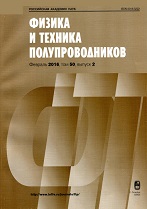|
|
Fizika i Tekhnika Poluprovodnikov, 2016, Volume 50, Issue 5, Pages 633–638
(Mi phts6464)
|
 |
|
 |
This article is cited in 2 scientific papers (total in 2 papers)
Amorphous, glassy, organic semiconductors
Piezoresistive and posistor effects in polymer-semiconductor and polymer-ferropiezoceramic composites
Havar A. Mamedova, Levent Paralib, Mirza A. Kurbanovc, Azad А. Bayramovc, Farida N. Tatardarc, Israfil Sabikoğlud
a Azerbaijan Technical University, Baku, Azerbaijan
b Celal Bayar University, Department of Electronics and Automation, Turgutlu, Manisa, Turkey
c Academy of Science of Azerbaijan, Institute of Physics, Baku, Azerbaijan
d Celal Bayar University, Faculty of Arts & Sciences, Departments of Physics, Manisa, Turkey
Abstract:
In this study, piezoresistive and posistor effects in polymer-semiconductor and polymer-ferropiezoceramic composites have been investigated. The results show that composites based on crystallizable polymers, such as PVDF, HDPE, and PP dispersed by semiconductors and ferropiezoelectric fillers have piezoresistive and posistor properties, respectively. At low pressure, charge carriers tunneling through the located thin polymer among filler particles into the barrier define the conductivity of the composite. When pressure value is increased from 0 to 1 MPa, the thickness of the interlayer decreases and tunnel conductivity descends exponentially depending on barrier height. The piezoresistor sensitivity of a composite based on PVDF-70% vol+Si-30% vol is higher than a composite based on HDPE-70% vol+Ge-30% vol. Furthermore, the posistor properties of polymer composites dispersed by ferropiezoceramic are determined as the maximum resistance that varies significantly with temperature. Posistor effect in composites based on polymer+ferropiezoceramic is associated with the height of the barrier layer, which changes according to properties of filler, polymer, and dielectric permittivity of two-phase composites. The highest specific resistance related to HDPE-70% vol+BaTiO$_{3}$-30% vol composite was observed at $\sim$403 K.
Keywords:
Dielectric Permittivity, Barrier Layer, HDPE, Azerbaijan, Filler Particle.
Received: 04.02.2015
Accepted: 10.09.2015
Citation:
Havar A. Mamedov, Levent Parali, Mirza A. Kurbanov, Azad А. Bayramov, Farida N. Tatardar, Israfil Sabikoğlu, “Piezoresistive and posistor effects in polymer-semiconductor and polymer-ferropiezoceramic composites”, Fizika i Tekhnika Poluprovodnikov, 50:5 (2016), 633–638; Semiconductors, 50:5 (2016), 621–626
Linking options:
https://www.mathnet.ru/eng/phts6464 https://www.mathnet.ru/eng/phts/v50/i5/p633
|


| Statistics & downloads: |
| Abstract page: | 50 | | Full-text PDF : | 21 |
|





 Contact us:
Contact us: Terms of Use
Terms of Use
 Registration to the website
Registration to the website Logotypes
Logotypes








 Citation in format
Citation in format 
